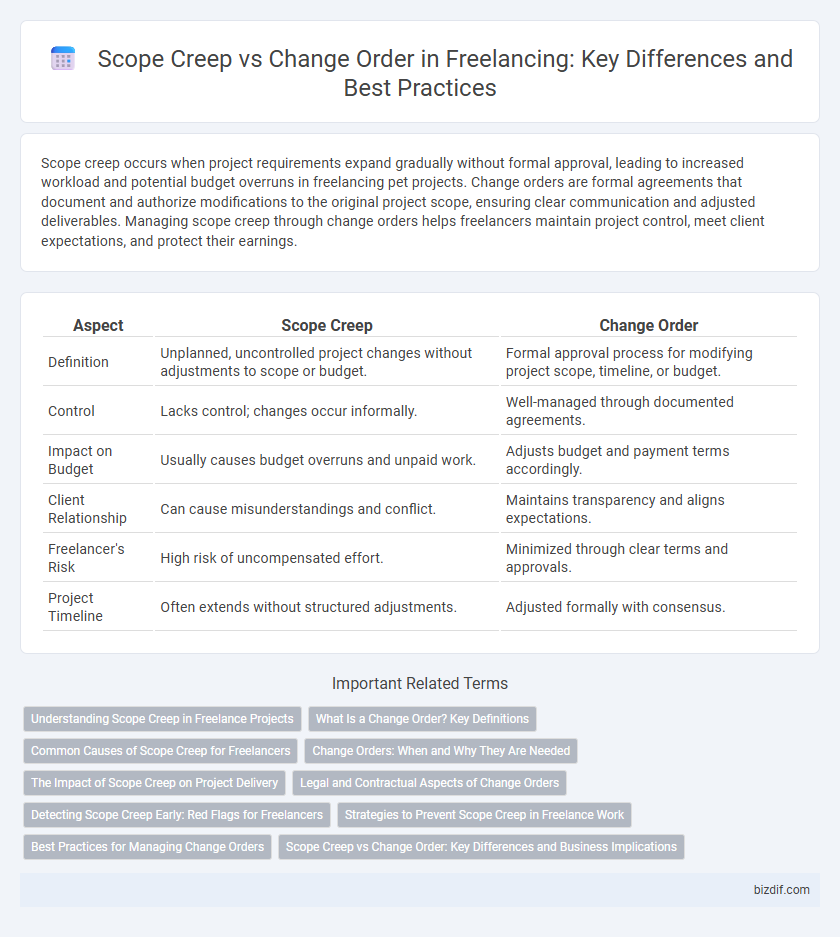Scope creep occurs when project requirements expand gradually without formal approval, leading to increased workload and potential budget overruns in freelancing pet projects. Change orders are formal agreements that document and authorize modifications to the original project scope, ensuring clear communication and adjusted deliverables. Managing scope creep through change orders helps freelancers maintain project control, meet client expectations, and protect their earnings.
Table of Comparison
| Aspect | Scope Creep | Change Order |
|---|---|---|
| Definition | Unplanned, uncontrolled project changes without adjustments to scope or budget. | Formal approval process for modifying project scope, timeline, or budget. |
| Control | Lacks control; changes occur informally. | Well-managed through documented agreements. |
| Impact on Budget | Usually causes budget overruns and unpaid work. | Adjusts budget and payment terms accordingly. |
| Client Relationship | Can cause misunderstandings and conflict. | Maintains transparency and aligns expectations. |
| Freelancer's Risk | High risk of uncompensated effort. | Minimized through clear terms and approvals. |
| Project Timeline | Often extends without structured adjustments. | Adjusted formally with consensus. |
Understanding Scope Creep in Freelance Projects
Scope creep in freelance projects occurs when clients continuously introduce new requirements or alterations beyond the initially agreed-upon scope without formal approval. This phenomenon often leads to project delays, budget overruns, and strained client relationships due to unclear boundaries and expectations. Freelancers mitigate scope creep by establishing detailed contracts, defining clear deliverables, and implementing structured change order processes to manage modifications efficiently.
What Is a Change Order? Key Definitions
A change order is a formal document that outlines modifications to the original scope of a freelancing project, including adjustments in tasks, timelines, or costs. It serves as an official agreement between freelancer and client to manage scope creep by clearly defining new deliverables and associated fees. Proper use of change orders ensures transparency and protects both parties from disputes related to project changes.
Common Causes of Scope Creep for Freelancers
Scope creep for freelancers often arises from unclear project requirements, insufficient client communication, and evolving client expectations during the project lifecycle. Frequent changes in deliverables, ambiguous contracts, and lack of defined project boundaries contribute to unplanned work beyond the original agreement. Managing scope creep involves setting clear project scopes, detailed contracts with change order procedures, and maintaining consistent client communication.
Change Orders: When and Why They Are Needed
Change orders are essential in freelancing projects to manage scope adjustments formally after initial agreements, preventing misunderstandings and ensuring clear communication between clients and freelancers. They are needed when project requirements evolve beyond the original scope, such as additional features, revised deadlines, or altered deliverables. Proper use of change orders protects both parties by documenting new terms, updating budgets, and modifying timelines to reflect the agreed changes.
The Impact of Scope Creep on Project Delivery
Scope creep significantly disrupts project delivery by causing unplanned expansions in project tasks without corresponding budget or timeline adjustments. This leads to resource strain, missed deadlines, and reduced quality in freelance projects. Proper management through formal change orders helps maintain clear project boundaries and ensures timely, efficient delivery.
Legal and Contractual Aspects of Change Orders
Scope creep occurs when project requirements expand beyond the original agreement without formal approval, often leading to disputes in freelance contracts. Legal and contractual aspects of change orders require clear documentation, explicit client consent, and agreed-upon adjustments to project timelines and fees to protect freelancers from unpaid work. Properly executed change orders serve as enforceable amendments, preventing ambiguity and maintaining contractual integrity in freelancing agreements.
Detecting Scope Creep Early: Red Flags for Freelancers
Detecting scope creep early is crucial for freelancers to maintain project timelines and budgets. Common red flags include frequent client requests for additional work without formal agreements, unclear project objectives, and shifting priorities that extend beyond the original contract. Tracking these signs helps freelancers initiate timely change orders, ensuring proper compensation and scope management.
Strategies to Prevent Scope Creep in Freelance Work
Defining detailed project deliverables and setting clear expectations with clients reduces scope creep in freelance work. Implementing formal change order processes ensures any modifications are documented, agreed upon, and billed appropriately. Utilizing project management tools to track progress and communicate regularly helps freelancers maintain control over project scope and deadlines.
Best Practices for Managing Change Orders
Managing change orders effectively requires clear communication and detailed documentation to prevent scope creep in freelancing projects. Establishing a formal change order process with defined approval steps ensures that all modifications are agreed upon, budgeted, and scheduled properly. Using project management tools to track change requests and their impact on timelines and costs helps maintain control and client satisfaction throughout the project lifecycle.
Scope Creep vs Change Order: Key Differences and Business Implications
Scope creep refers to the uncontrolled expansion of project deliverables without corresponding adjustments in budget, timeline, or resources, often leading to missed deadlines and strained client relationships. In contrast, a change order is a formal agreement that documents approved modifications to the original project scope, ensuring clear communication and proper compensation for additional work. Understanding the key differences between scope creep and change orders is essential for freelancers to maintain project control, avoid revenue loss, and uphold professional credibility.
Scope Creep vs Change Order Infographic

 bizdif.com
bizdif.com